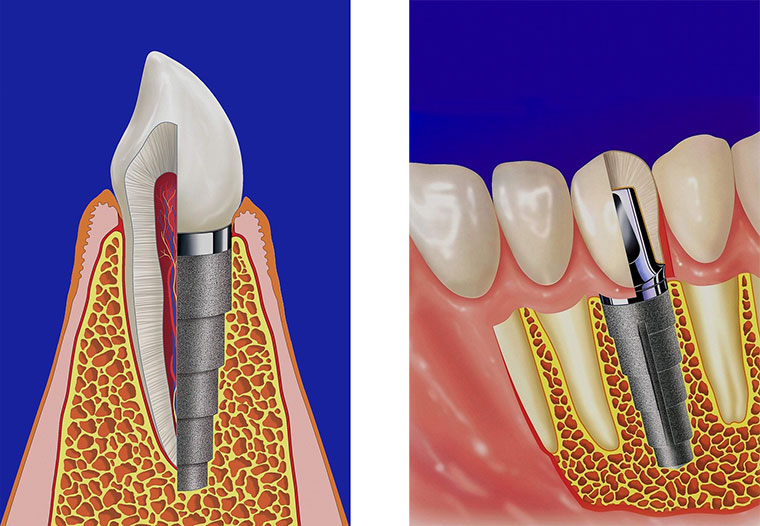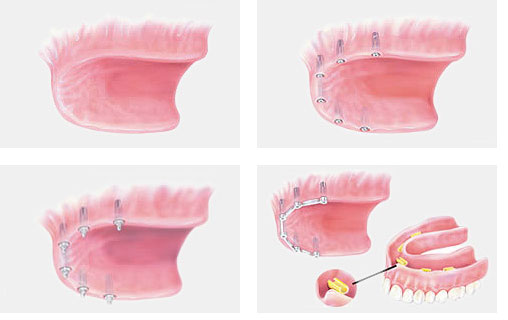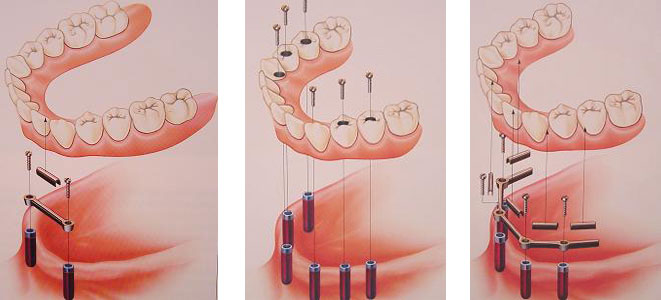Implants are artificial roots, which are made of titanium and have very special construction techniques, instead of the extracted teeth, placed in the root socket, that is, in the bone.

Implants are made of substances that do not have any side effects for the organism, and have been undergoing extensive research for years. Implants are mostly made of biocompatible materials called titanium. Since titanium is not a living substance, it does not produce an antigen-antibody reaction as in heart and kidney transplantations. Therefore, a “tissue rejection” cannot be mentioned.
For the implant construction, young people’s bone development needs to be completed. After 16 years of age, bone development is considered to be approximately complete and it makes it possible to make implants after this age. There is no upper age limit for adults. It can be applied to people of any age, whose general health is appropriate. Older people need implant support more because they lose more teeth and have resorption in their jaw bones and the problems of stabilization (playing, mobility) of the prostheses they use. Thus, they lead a happier life as they have more performance, stable and more aesthetic prostheses.

Dental implants prevent bone loss. Normally, when a tooth is pulled, it melts in the bone tissues in the extracted region. This is a physiological meltdown that we don’t want. If an implant is applied to that area immediately after tooth extraction, this bone loss does not occur. Thus, because there is no bone loss in that area, gingival recession is not seen and aesthetic results are much better.
There is no better option than the implant that maintains the amount of bone in the draft site!
What are the advantages of implant treatment?
– Better aesthetic appearance
– Better chewing
– A happier social life with the recovery of self-confidence
Healthier and balanced diet depending on being able to eat everything
Implants give you teeth in the most natural image. It gives the impression of your own natural tooth while chewing. It is impossible to say that the natural tooth can never be replaced. However, it is the closest form of treatment!
It is a safer, functional alternative treatment method compared to traditional coating, bridge and palate prostheses.
Implant treatments consist of two stages. Surgical stage and superstructure stage. An average of 1.5-2 months is expected after implants are placed surgically. This waiting period is the time required for the implant called “osteointegration” to biodegrade with the jaw bone.
After this period, the second phase, the superstructure phase, is completed in an average week.
Immediate Implantation can be performed (promptly, without waiting) when certain favorable conditions are met. For example, it is possible to replace the broken teeth (especially below the bone level) immediately after implantation (immediate implantation). Even temporary temporary loading, which will close the bad aesthetics caused by the lack of teeth, can also be made permanent teeth if necessary and suitable (immediate permenant loading).
What advantages does implant treatment offer in which cases?
a) Patients who have lost all their teeth in the upper and lower jaw and carrying prostheses:

These patients complain of constant pain (bumps) due to the movement of the prosthesis and not being able to chew well. This complaint increases with the dissolution of bone tissue that supports prosthesis over time. In such patients, implant treatment eliminates all the above complaints and also stops the melting of the bone.
All kinds of toothlessness and missing functions can be eliminated with implants and implant prostheses supported by them. The patient gets rid of partial-partial dentures. In the case of complete toothlessness, fixed prostheses can be made (with sufficient number of implants) instead of prostheses (palates) which are attached and removed.
Implant supported movable prostheses are applied in cases where fixed prostheses cannot be made (due to insufficient bone support in the back areas or for economic reasons). It is generally recommended to use at least two implants to support these prostheses, or even 4 to increase comfort.

Acrylic resin can be used as base material in these prostheses, as well as metal + ceramic or zircon + ceramic base (hybrid prostheses). It is preferred to use acrylic resin tool teeth to transmit less chewing forces to the supporting tissues and implants. Prostheses are attached to implants with some holding elements (attachments-bars). In order to clean the implant-holding element perimeter and the prosthesis, it must be removed after meals and hygiene requirements must be met in the technique recommended by the physician.

b) Patients who have lost some of their teeth in the lower or upper jaw:

The complaints of these patients can be counted as the ugly appearance of the prosthesis, which is attached with hooks, or the necessity of cutting their solid teeth to make a bridge. Multiple tooth deficiencies can be eliminated by making fixed bridges with the help of implants instead of prosthetics. Implant-supported fixed prostheses are usually applied in the missing tooth (s) area when there is a good quality and sufficient amount of bone to support the implant to be placed. Prostheses that are fixed on one or more implants by means of screws (s) or adhesive (dental cement).
It can be applied in single tooth deficiencies or in partial tooth deficiencies and in complete toothlessness. If the prosthesis is fixed with screws, the entrance hole of the screw is closed by the physician with a composite resin filling material (beam-hardening filling). It is similar to traditional fixed prostheses (crowns-bridges) placed by the physician and not removed by the patient. Depending on the condition of these prostheses, prostheses made of porcelain or completely porcelain are also applied on a metal substructure.

c) Patients who have lost a single tooth:

In classical treatment methods, the support of at least two adjacent teeth is needed for the restoration of a single tooth. Single tooth implant applications should be considered in order to eliminate the single tooth deficiency without touching the adjacent intact teeth. In such cases, by placing a single implant, neighboring teeth are saved, resulting in more aesthetic and functional results.
It is not possible to feel pain during the operation if appropriate anesthesia methods are applied. (!) General or local anesthesia can be performed according to the patient’s preference during the operation. After the operation, there may be a pain and a slight edema as much as after the extraction. This pain, which can usually be heard in the evening when the implant is placed, can be removed with simple painkillers. In cases where the treatment is completed without any problems, even the presence of implants is so comfortable that it cannot be felt.

The success of the dental implant depends on how much bone is in the place where the implant will be placed. The decrease in the amount and quality of the bone depends on many factors such as gingival problems, infection or trauma. But with today’s advanced techniques (Aughmentation techniques), the width and height of the bone can be increased.
With some special techniques, anatomical spaces such as bone destruction areas and sinus (sinus lifting) are filled so that the seat of the implant is prepared. Your clinical examination and x-rays are evaluated before the operation, and you will be told if you will need bone grafts (bone powder or bone block). As the bone grafts, autogenous-natural (taken from the patient), synthetic-artificial or a mixture of the two are generally used.
Care of Implants:
As it is important for your natural teeth, first of all, oral hygiene is very important for implants. Otherwise, we will lose implants just as natural teeth are lost. If meticulous brushing is not applied to the implants and gums, swelling, redness and bleeding starts in the gums (Periimplantit). This is followed by osteoporosis and destruction continues until implant loss.
Another important issue is smoking. It is recommended not to smoke, especially since it will negatively affect recovery after the operation. It should be remembered that it will reduce the level of success by 10%!
In scientific studies, it has been observed that implant success varies between 95-97% in the lower jaw and 93-95% in the upper jaw. However, as with any medical intervention, it is not possible and accurate to provide warranty for implants. Patients can keep their implant health and lifetime under control due to dental health by going to their physicians for control in 6-month periods.

